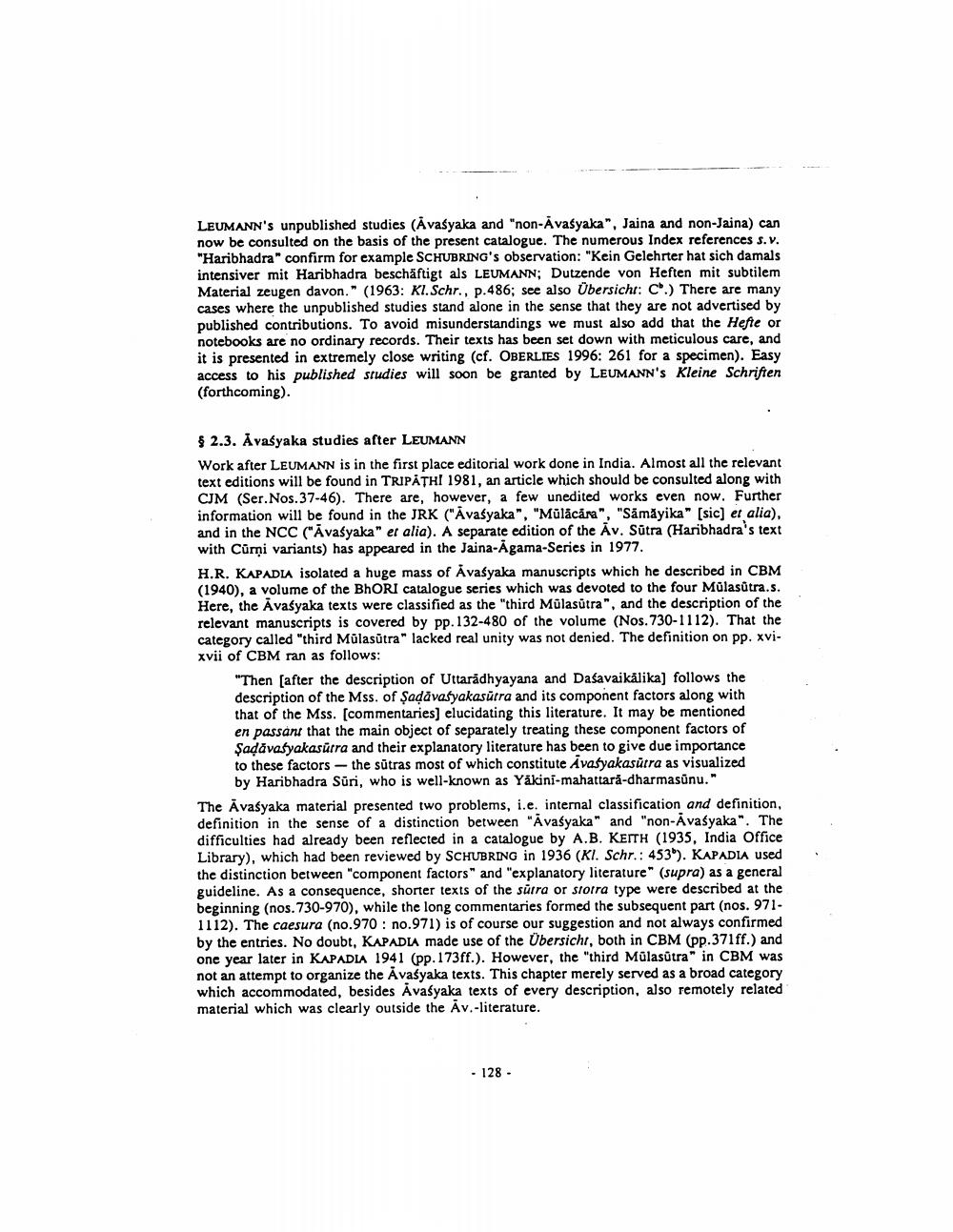________________
LEUMANN's unpublished studies (Avaśyaka and "non-Avasyaka", Jaina and non-Jaina) can now be consulted on the basis of the present catalogue. The numerous Index references s.v. "Haribhadra" confirm for example SCHUBRING's observation: "Kein Gelehrter hat sich damals intensiver mit Haribhadra beschäftigt als LEUMANN; Dutzende von Heften mit subtilem Material zeugen davon." (1963: Kl. Schr., p.486; see also Übersicht: C.) There are many cases where the unpublished studies stand alone in the sense that they are not advertised by published contributions. To avoid misunderstandings we must also add that the Hefte or notebooks are no ordinary records. Their texts has been set down with meticulous care, and it is presented in extremely close writing (cf. OBERLIES 1996: 261 for a specimen). Easy access to his published studies will soon be granted by LEUMANN's Kleine Schriften (forthcoming).
$ 2.3. Avasyaka studies after LEUMANN Work after LEUMANN is in the first place editorial work done in India. Almost all the relevant text editions will be found in TRIPATHI 1981, an article which should be consulted along with CJM (Ser. Nos. 37-46). There are, however, a few unedited works even now. Further information will be found in the JRK ("Āvaśyaka", "Mülăcăra", "Sämāyika" [sic] et alia), and in the NCC ("Avasyaka" et alia). A separate edition of the Av. Sūtra (Haribhadra's text with Curņi variants) has appeared in the Jaina-Agama-Series in 1977. H.R. KAPADIA isolated a huge mass of Avasyaka manuscripts which he described in CBM (1940), a volume of the BhORI catalogue series which was devoted to the four Mülastra.s. Here, the Avašyaka texts were classified as the "third Mülasutra", and the description of the relevant manuscripts is covered by pp. 132-480 of the volume (Nos. 730-1112). That the category called "third Mülasutra" lacked real unity was not denied. The definition on pp. xvixvii of CBM ran as follows:
"Then (after the description of Uttaradhyayana and Dasavaikälika) follows the description of the Mss. of Şadāvasyakasutra and its component factors along with that of the Mss. [commentaries) elucidating this literature. It may be mentioned en passant that the main object of separately treating these component factors of Şadavasyakasurra and their explanatory literature has been to give due importance to these factors - the sūtras most of which constitute Avastyakasūtra as visualized
by Haribhadra Suri, who is well-known as Yäkini-mahattara-dharmasünu." The Avasyaka material presented two problems, i.e. internal classification and definition, definition in the sense of a distinction between Avaśyaka" and "non-Avasyaka". The difficulties had already been reflected in a catalogue by A.B. KEITH (1935, India Office Library), which had been reviewed by SCHUBRING in 1936 (KI. Schr.: 453'). KAPADIA used the distinction between "component factors" and "explanatory literature" (supra) as a general guideline. As a consequence, shorter texts of the surra or storra type were described at the beginning (nos.730-970), while the long commentaries formed the subsequent part (nos. 9711112). The caesura (no.970: no.971) is of course our suggestion and not always confirmed by the entries. No doubt, KAPADIA made use of the Übersicht, both in CBM (pp.371ff.) and one year later in KAPADIA 1941 (pp. 173ff.). However, the "third Mülasutra" in CBM was not an attempt to organize the Avaśyaka texts. This chapter merely served as a broad category which accommodated, besides Avaśyaka texts of every description, also remotely related material which was clearly outside the Av.-literature.
. 128




